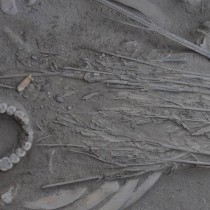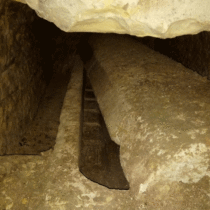An ancient Egyptian tomb of a noblewoman has yielded the first material evidence supporting the application of a certain gynecological treatment which was only known from medical papyri.
The tomb came to light in Qubbat al-Hawa, a site on the slope of a hill west of Aswan. It belongs to the site’s ancient cemetery of rock-cut tombs, which extend in four levels along the slope. It is designated as 34aa, it dates to the Late 12th Dynasty and it belongs to an elite lady identified as Sattjeni A. The tomb has been excavated by the Spanish mission led by Dr. Alejandro Jiménez-Serrano (University of Jaen), which explores the site since 2008.
Among the finds, a hemispherical drinking cup located between the heads of the femurs of Sattjeni A triggered a particular interest for the team, both due to its position as well as the “remains of organic material with evident signs of combustion” found in its interior. In an article recently published in the prominent Egyptological journal ZÄS the find is described as a “ceramic pot containing burnt remains between its [the body’s] legs, which were originally covered”.
The find led to interdisciplinary research that combined the study of material evidence with ancient textual sources and biomedical elements. In the framework above, the Jaen-based team of archaeologists collaborated with anthropologists from the University of Granada, again in Spain.
According to the article, the team found that the woman had suffered a traumatic injury in her pelvis, which provoked her pain, sterility, and iatrogenic pain. In fact, she had suffered “an injury to her pelvis, possibly due to a fall that caused severe pain.”, which had to be treated. And this is where the ceramic comes along.
Researchers associated the pot and its content with descriptions of similar treatments recorded in different papyri. One of them known as the Kahun Gynaecological Papyrus (and also as Petrie Medical Papyrus, Kahun Medical Papyrus, Lahun Medical Papyrus, or UC32057) is almost contemporary to the burial, also dating to 1800 BC. In several passages from the text, the ancient physician is referred to the practice of “fumigation”, the burning of different materials (the mixtures varied according to each medical case) in a covered pot, in order to produce steam or smoke with healing abilities.
The analysis of this and other textual sources has allowed the team to relate this find to the medical treatments prescribed by the ancient specialists in the 12th Dynasty.




